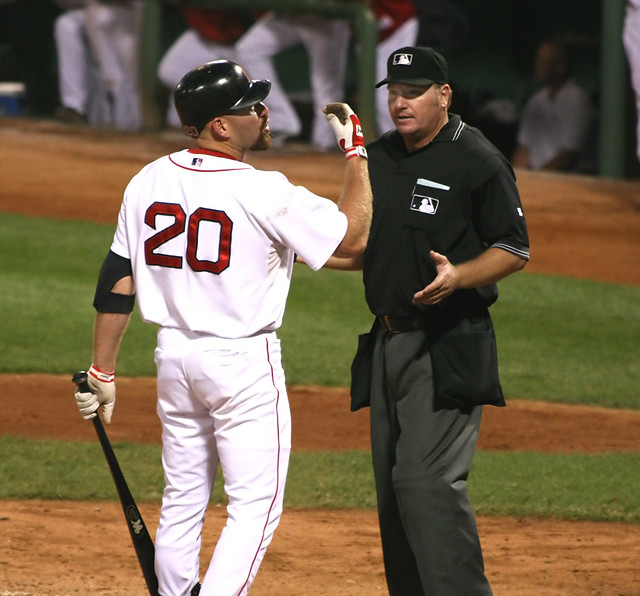
Kevin Youkilis in a familiar pose with umpire Brian Runge (photo: Samara Pearlstein)
By now you’ve all heard that Kevin Youkilis has signed a one-year, $12 million contract with the hated New York Yankees. In his introductory press conference, Youkilis said, “It was more of a shock at first of like ‘Oh my God, I never thought I’d have the Yankees call me and want me on their team.'” I hold no animosity toward Youkilis for signing with the Yankees, as he had already been traded to the White Sox and he definitely deserves a job in the majors, so good luck, Kevin. What I want to do is remember what number 20 meant to the Red Sox.
Wait.
Number 20.
Twenty.
I don’t want to talk about Kevin Youkilis anymore. I want to talk about 20 children who were murdered in Newtown, CT. Twenty-year-old Adam Lanza, after killing his mother at her home, entered the Sandy Hook Elementary School clad in black fatigues and a military bullet-proof vest, armed with a Glock and a Sig Sauer (both semi-automatic handguns) and plenty of ammunition. He then proceeded to kill the principal of the school, a school psychologist, four teachers and twenty children (ranging from the ages of five to ten) before taking his own life.
Twenty children. Twenty.
That’s 20 children who will never experience the joy of holding their mother or father’s hand and enter Yankee Stadium to see Kevin Youkilis (supposedly) wearing his familiar #20. Twenty children who will never again ride their bikes with baseball cards in the spokes. Twenty fewer voices root, root, rooting for the home team. Twenty children who will never get a chance to be the next Mike Trout or Jennie Finch. Twenty.
It is way beyond time to have a conversation about serious gun control in the United States.
“You heartless bastard,” you might say. “Now is not the time to have this discussion. Let the parents grieve. We can have this discussion later.”
I guess you’re right. Now isn’t the time to have this discussion. And it wasn’t the time to discuss reasonable gun control after the shooting at a mall in Portland, Oregon this past Tuesday (two dead, one injured). And it definitely wasn’t the time to discuss it after the mass killing in Minnesota on September 27 (five dead, three injured). Nor was it the time to discuss it after the mass killing at the Sikh temple in Milwaukee on August 5 (10 killed or injured). It surely wasn’t the time to discuss it after the killings at a movie theater in Aurora, Colorado on July 20 (70 killed or injured). We couldn’t discuss the issue on or about May 20, after the shooting at a Seattle cafe (seven killed or injured). How dare we discuss the issue after the shooting at Oikos University in Oakland (10 killed or injured) on April 20. It would have been insensitive to discuss the issue after the shooting at a spa in Norcross, Georgia on February 22 (five killed or injured).
It wasn’t the time to discuss gun control after Rep. Gabby Giffords was shot (along with 18 others) in Tuscon. Nor after Fort Hood. Or after Northern Illinois University. Or after Virginia Tech. Or after the killings at the Amish school in Lancaster, PA. Or after Red Lake, Minnesota. Or after Brookfield, Wisconsin. Or after the Damageplan concert in Columbus, Ohio. Or after Lockheed-Martin. Or after Wakefield, Massachusetts. Or after the killings at the Baptist church in Fort Worth. Or after the Atlanta day-traders office. Or after Columbine.
You’re right. Now isn’t the best time to discuss gun control in America. That time was before any one of those twenty shootings. But because we failed all those victims, including twenty children in Newtown, Connecticut, by our refusal to discuss gun control in America after any one of those previous massacres, we owe it to the myriad victims and their families to have this discussion.
Now.
